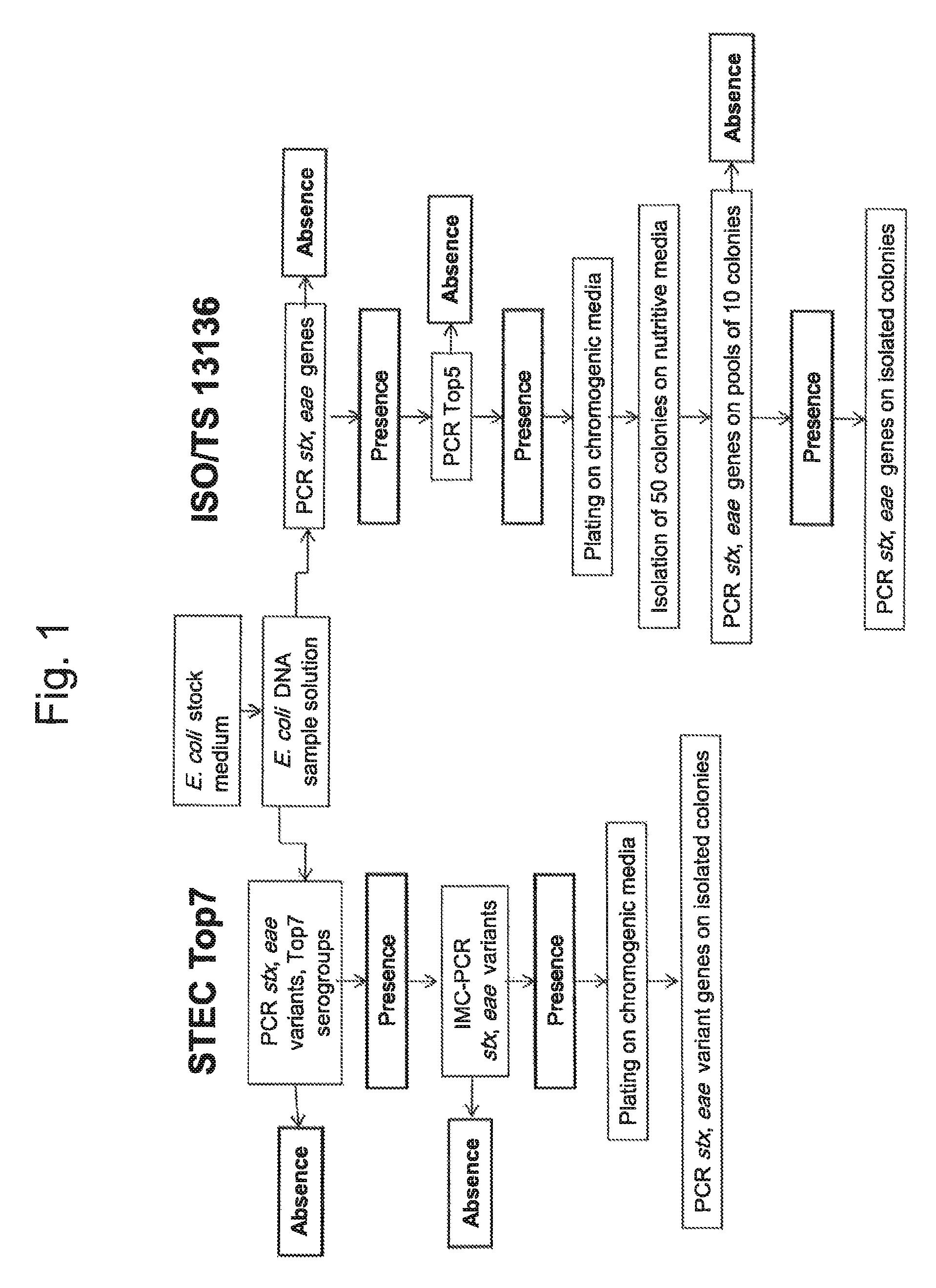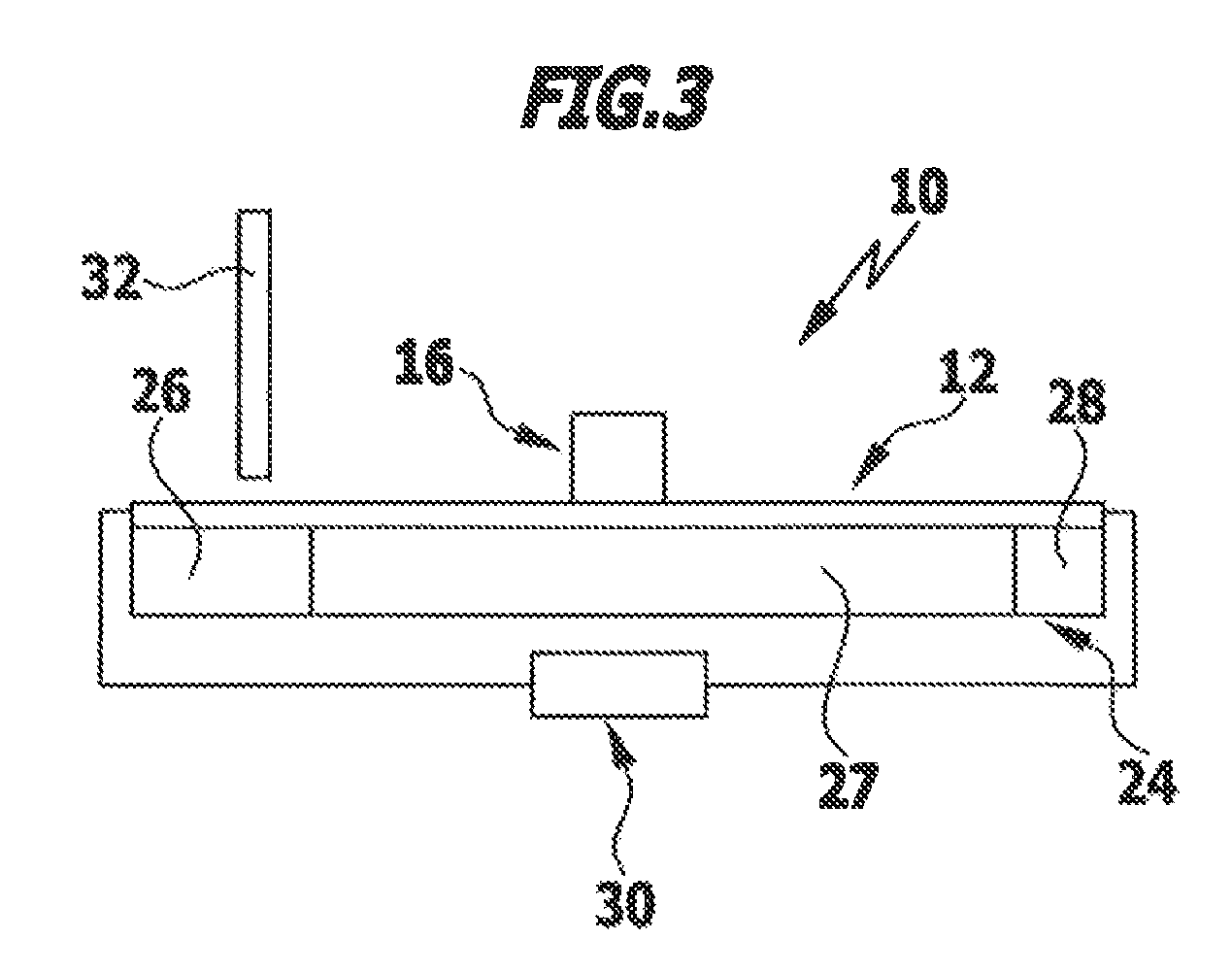Method for determining the presence or absence of shiga toxin-producing Escherichia coli (STEC) in a food sample
a technology of escherichia coli and food samples, which is applied in the direction of microorganism testing/measurement, biochemistry apparatus and processes, etc., can solve the problems of false positive and time-consuming procedure of subsequent detection of the above-mentioned serogroups in the samples using conventional methods
- Summary
- Abstract
- Description
- Claims
- Application Information
AI Technical Summary
Benefits of technology
Problems solved by technology
Method used
Image
Examples
example 1
Raw Beef Meat (25 g)
[0108]The GeneDisc STEC Top7 method was evaluated on 2,476 fresh minced beef samples collected in supermarkets of 92 departments of France. 25 g of each sample were admixed with 225 mL of buffered peptone water then incubated at 37° C. for 18 h to 24 h. After PCR screening, bacterial isolation by direct plating was performed from PCR positive samples, according to the ISO 13136 technical specification recommendations. The purpose of this study was to compare the screening approach described in the ISO 13136 technical specification (stx, eae and serogroup) to the STEC Top7 screening approach including the eae variants (subtypes) instead of the generic eae gene. The results are reported in Table 4.
[0109]
TABLE 4Evaluation of the entire GeneDisc STEC Top7 method with 2,476naturally contaminated fresh minced beef samples.Fresh minced beefPrevalenceScreening stepsNumber%Total number of samples2,476100stx+, eae+, Top7+843.4stx+, eae variant+, Top7+291.2Colony isolation7...
example 2
Raw Dairy Products (25 g)
[0111]The GeneDisc STEC Top7 method was evaluated on 1,448 raw dairy products including 1,072 raw milk samples and 376 raw milk cheeses. 25 g of each sample were diluted in 225 mL of buffered peptone water supplemented with novobiocin (10 mg / L). Samples were incubated at 37° C. for 18h+2h. The purpose of this Example was to compare the screening approach described in the ISO13136 technical specification (stx, eae and serogroup) to the STEC Top7 screening approach including the eae variants instead of the generic eae gene. The results are reported in the Table 5.
[0112]
TABLE 5Evaluation of the entire GeneDisc STEC Top7 method with 1,448 naturally contaminatedraw dairy samples.Raw milkRaw milk cheesePrevalencePrevalenceGlobalScreening stepsNumber%Number%prevalenceTotal number of samples1,072100376100100stx+, eae+, Top7+24522.916042.628.0stx+, eae variant+, Top7+16315.210427.718.4IMC-PCR conform403.7369.65.2Colony isolation70.761.60.9
[0113]The results showed aga...
example 3
Raw Beef Meat (375 g)
[0114]Evaluation of the entire method was also realized on 375 g raw beef meat samples, including 400 ground beef samples and 150 beef trim samples processed in 4 facilities across the US. The inventive GeneDisc method was compared to the USDA-FSIS MLG 5B.01 method. 375 g of each sample were diluted in either 1.5 L of mTSB or 975 mL of mTSB with novobiocin (mTSBn). Samples were incubated at 42° C. The incubation time depended on the enrichment broth: 12 h for the mTSB, 15 h for the mTSBn. Presumptive positive samples were confirmed according to reference methods (USDA-FSIS MLG 5 & 5B.01). The results are reported in Table 6.
[0115]
TABLE 6Evaluation of the entire GeneDisc STEC Top7 method with 550naturally contaminated raw beef meat samples.USDA-FSIS methodGeneDisc STEC Top7 methodMLG 5 & 5B.01EnrichmentPCR positivePCR positiveSample typebrothsamplesConfirmationsamplesConfirmationGround Beef mTSB (12 h)0 / 400NA0 / 400NAmTSBn (15 h)1 / 400 1 / 1 (O157)9 / 4001 / 8 (O157)Beef ...
PUM
| Property | Measurement | Unit |
|---|---|---|
| temperatures | aaaaa | aaaaa |
| temperatures | aaaaa | aaaaa |
| temperatures | aaaaa | aaaaa |
Abstract
Description
Claims
Application Information
 Login to View More
Login to View More - R&D
- Intellectual Property
- Life Sciences
- Materials
- Tech Scout
- Unparalleled Data Quality
- Higher Quality Content
- 60% Fewer Hallucinations
Browse by: Latest US Patents, China's latest patents, Technical Efficacy Thesaurus, Application Domain, Technology Topic, Popular Technical Reports.
© 2025 PatSnap. All rights reserved.Legal|Privacy policy|Modern Slavery Act Transparency Statement|Sitemap|About US| Contact US: help@patsnap.com



